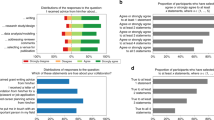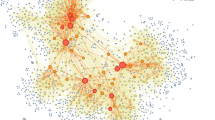Abstract
The role of mentorship in protégé performance is a matter of importance to academic, business and governmental organizations. Although the benefits of mentorship for protégés, mentors and their organizations are apparent1,2,3,4,5,6,7,8,9, the extent to which protégés mimic their mentors’ career choices and acquire their mentorship skills is unclear10,11,12,13,14,15,16. The importance of a science, technology, engineering and mathematics workforce to economic growth and the role of effective mentorship in maintaining a ‘healthy’ such workforce demand the study of the role of mentorship in academia. Here we investigate one aspect of mentor emulation by studying mentorship fecundity—the number of protégés a mentor trains—using data from the Mathematics Genealogy Project17, which tracks the mentorship record of thousands of mathematicians over several centuries. We demonstrate that fecundity among academic mathematicians is correlated with other measures of academic success. We also find that the average fecundity of mentors remains stable over 60 years of recorded mentorship. We further discover three significant correlations in mentorship fecundity. First, mentors with low mentorship fecundities train protégés that go on to have mentorship fecundities 37% higher than expected. Second, in the first third of their careers, mentors with high fecundities train protégés that go on to have fecundities 29% higher than expected. Finally, in the last third of their careers, mentors with high fecundities train protégés that go on to have fecundities 31% lower than expected.
This is a preview of subscription content, access via your institution
Access options
Subscribe to this journal
Receive 51 print issues and online access
$199.00 per year
only $3.90 per issue
Buy this article
- Purchase on Springer Link
- Instant access to full article PDF
Prices may be subject to local taxes which are calculated during checkout




Similar content being viewed by others
References
Kram, K. E. Mentoring at Work: Developmental Relationships in Organizational Life (Scott Foresman, 1985)
Chao, G. T., Walz, P. M. & Gardner, P. D. Formal and informal mentorships: a comparison on mentoring functions and contrast with nonmentored counterparts. Person. Psychol. 45, 619–635 (1992)
Scandura, T. A. Mentorship and career mobility: an empirical investigation. J. Organ. Behav. 13, 169–174 (1992)
Aryee, S., Chay, Y. W. & Chew, J. The motivation to mentor among managerial employees. Group Organ. Manage. 21, 261–277 (1996)
Allen, T. D., Poteet, M. L., Russell, J. E. A. & Dobbins, G. H. A field study of factors related to supervisors’ willingness to mentor others. J. Vocat. Behav. 50, 1–22 (1997)
Donaldson, S. I., Ensher, E. A. & Grant-Vallone, E. J. Longitudinal examination of mentoring relationships on organizational commitment and citizenship behavior. J. Career Dev. 26, 233–249 (2000)
Payne, S. C. & Huffman, A. H. A longitudinal examination of the influence of mentoring on organizational commitment and turnover. Acad. Manage. J. 48, 158–168 (2005)
Kram, K. E. & Isabella, L. A. Mentoring alternatives: the role of peer relationships in cancer development. Acad. Manage. J. 28, 110–132 (1985)
Higgins, M. C. & Kram, K. E. Reconceptualizing mentoring at work: a developmental network perspective. Acad. Manage. Rev. 26, 264–283 (2001)
Allen, T. D., Poteet, M. L. & Burroughs, S. M. The mentor’s perspective: a qualitative inquiry and future research agenda. J. Vocat. Behav. 51, 70–89 (1997)
Green, S. G. & Bauer, T. N. Supervisory mentoring by advisers: relationships with doctoral student potential, productivity, and commitment. Person. Psychol. 48, 537–562 (1995)
Singh, R., Ragins, B. R. & Tharenou, P. Who gets a mentor? A longitudinal assessment of the rising star hypothesis. J. Vocat. Behav. 74, 11–17 (2009)
Allen, T. D., Poteet, M. L. & Russell, J. E. A. Protégé selection by mentors: what makes the difference? J. Organ. Behav. 21, 271–282 (2000)
Allen, T. D. Protégé selection by mentors: contributing individual and organizational factors. J. Vocat. Behav. 65, 469–483 (2004)
Ragins, B. R. & Scandura, T. A. Burden or blessing? Expected costs and benefits of being a mentor. J. Organ. Behav. 20, 493–509 (1999)
Paglis, L. L., Green, S. G. & Bauer, T. N. Does adviser mentoring add value? A longitudinal study of mentoring and doctoral student outcomes. Res. High. Ed. 47, 451–476 (2006)
North. Dakota State University. The Mathematics Genealogy Project 〈http://genealogy.math.ndsu.nodak.edu〉 (accessed, November 2007)
Bourne, P. E. & Fink, J. L. I am not a scientist, I am a number. PLoS Comput. Biol. 4, e1000247 (2008)
Enserink, M. Are you ready to become a number? Science 323, 1662–1664 (2009)
King, J. A review of bibliometric and other science indicators and their role in research evaluation. J. Inf. Sci. 13, 261–276 (1987)
Moed, H. F. Citation Analysis in Research Evaluation (Springer, 2005)
Hirsch, J. E. An index to quantify an individual’s scientific research output. Proc. Natl Acad. Sci. USA 102, 16569–16572 (2005)
Bishop, C. M. Pattern Recognition and Machine Learning (Springer, 2007)
Athreya, K. B. & Ney, P. E. Branching Processes (Courier Dover, 2004)
Milo, R., Kashtan, N., Itzkovitz, S., Newman, M. E. J. & Alon, U. On the uniform generation of random graphs with prescribed degree sequences. Preprint at 〈http://arxiv.org/abs/cond-mat/0312028〉 (2004)
Itzkovitz, S., Milo, R., Kashtan, N., Newman, M. E. J. & Alon, U. Reply to “Comment on ‘Subgraphs in random networks’”. Phys. Rev. E 70, 058102 (2004)
Hardy, G. H. A Mathematician’s Apology (Cambridge Univ. Press, 1940)
Stauffer, D. & Aharony, A. Introduction to Percolation Theory 2nd edn (Taylor & Francis, 1992)
Chapman, B. & Chang, J. Biopython: python tools for computational biology. ACM SIGBIO Newslett. 20, 15–19 (2000)
D’Agostino, R. B. & Stephens, M. A. Goodness-of-Fit Techniques (Dekker, 1986)
Acknowledgements
We thank R. Guimerà, P. McMullen, A. Pah, M. Sales-Pardo, E. N. Sawardecker, D. B. Stouffer and M. J. Stringer for comments and suggestions. L.A.N.A. gratefully acknowledges the support of US National Science Foundation awards SBE 0830388 and IIS 0838564. All figures were generated using PYGRACE (http://pygrace.sourceforge.net) with colour schemes from ColorBrewer 2.0 (http://colorbrewer.org).
Author information
Authors and Affiliations
Contributions
R.D.M. analyzed data, designed the study and wrote the paper. J.M.O. and L.A.N.A. designed the study and wrote the paper.
Corresponding authors
Ethics declarations
Competing interests
The authors declare no competing financial interests.
Supplementary information
Supplementary Information
This file contains Supplementary Figures 1-4 with legends and a Supplementary Discussion. (PDF 527 kb)
Rights and permissions
About this article
Cite this article
Malmgren, R., Ottino, J. & Nunes Amaral, L. The role of mentorship in protégé performance. Nature 465, 622–626 (2010). https://doi.org/10.1038/nature09040
Received:
Accepted:
Issue Date:
DOI: https://doi.org/10.1038/nature09040
This article is cited by
-
Exploring the determinants of research performance for early-career researchers: a literature review
Scientometrics (2024)
-
SciSciNet: A large-scale open data lake for the science of science research
Scientific Data (2023)
-
On the banks of Shodhganga: analysis of the academic genealogy graph of an Indian ETD repository
Scientometrics (2023)
-
Untangling the network effects of productivity and prominence among scientists
Nature Communications (2022)
-
A dataset of mentorship in bioscience with semantic and demographic estimations
Scientific Data (2022)
Comments
By submitting a comment you agree to abide by our Terms and Community Guidelines. If you find something abusive or that does not comply with our terms or guidelines please flag it as inappropriate.



